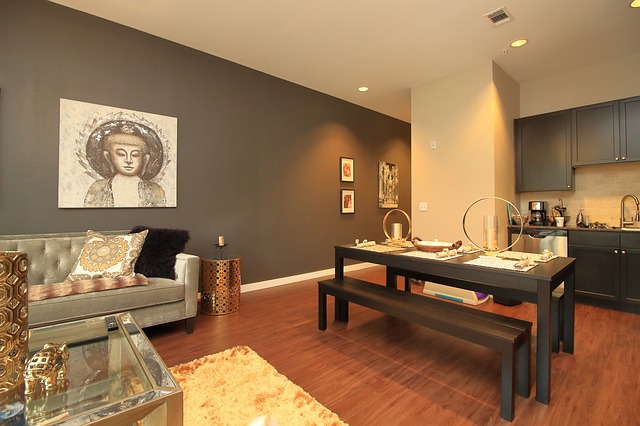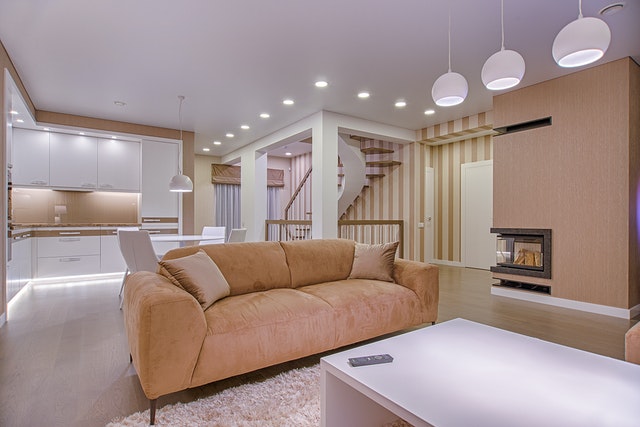
Staged homes sell faster and for a higher sales price than un-staged homes. When you stage a house before selling it, you take what was just a piece of real estate and transform it into buyers’ dream home.
Staging a home helps potential buyers connect with it at an emotional level; it lets them visualize themselves living in the house. A staged home has an overall more excellent appeal to buyers because it feels more spacious and appears more move-in ready, explains Blue Mountain Management.
However, to make the most impression on buyers, you have to approach each element of home staging strategically. Among the tools stagers use when staging a home – furniture, lighting, color and décor – color is probably the most important. This is because a room’s colors set the tone for all other style and design elements.
Color is a powerful tool for staging a home
The goal of staging should be to evoke a specific emotion in buyers as soon as they enter a room. You want them to feel positive emotions that make them more likely to want to buy the home. And the best way to do this is through the right use of colors. Colors possess a fantastic ability to make people sad or happy, angry or loving, etc. And you can use that power to a significant effect.
To masterfully stage a home to make it sell faster and for more money, you have to know how to deploy colors. To do that you need three things, at least:
- You have to clearly identify the mood you want buyers to be in when they enter a room.
- You have to identify the shades of colors that are associated with that particular mood
- You must know how to subtly but effectively infuse those colors into the design

Below we outline the psychological effects of different colors and how you can use them to stage a home with significant impact.
The psychological effect of different colors
As a rule, neutral tones should be used as the main colors of a room because they have the broadest appeal among potential buyers. Bold and bright colors are better used as accent colors to spice up neutral colors. Here is how to do that.
To create an atmosphere of comfort, trust and reliability
Brown hues in a room make it feel earthy. It transplants the natural comfort of nature into the room because brown associates with the strength of a tree. Lighter hues – tans and mushroom – make a perfect backdrop for bold accent colors. Dark shades – chocolate, mahogany or walnut – are great for room furnishings.
For calm and clarity and focus
To invoke a sense of harmony and serenity, use blue. Blue color is calm, soothing, and suitable for bedrooms or offices. Paler hues have almost universal appeal and can be used as a neutral color. They also blend easily with other colors. Darker shades may be used as accent colors; they balance perfectly with white, gray, and natural-toned furnishings.
To add elegance and dignity
Black and grays add depth that is at once mysterious, elegant, sophisticated and stable. Black should be used in small doses as it can feel oppressive in large amounts. Shades of gray, combined with black, create a sense of chic. Black furnishing is perfect for offsetting white and gray.
To create warmth and energy

Red invokes energy. It is stimulating and reminiscent of passion and love; it creates spikes in the adrenaline level. It should be used mostly as an accent color in rooms where people are encouraged to be lively. Shades of red, like orange and pink tones, are perfect as accent colors in places that are used for entertainment and where the family gathers.
To evoke a sense of luxury and sophistication
To impose a luxuriant feel in a room, use shades of purple. Purple is associated with royalty, luxury and wealth, and it is highly versatile and blends perfectly with many other colors. Lilac and orchid evoke creativity and maturity. Using purple as an accent color injects vitality into the bedroom. Incorporating purple in furnishings will capture buyers’ attention.
To add vibrancy, harmony and balance
Green can be used as a neutral or bold color. Being the color of nature, it makes rooms feel more vibrant. And because it blends easily with other colors, it is also harmonizing. Deeper shades of green are more calming, while lighter shades are more energizing. Apart from use as a wall color, green plants create the same effect in a room.
To inspire feelings of positivity
To inspire happiness and abundance, use more yellow. Bright yellow is over stimulating and should be used in small amounts. Paler shades of yellow – butter and banana yellow – are great for kitchens. Deeper hues like mustard are better for living spaces. Using shades of yellow as an accent color will create optimism in any room.
The starting point for using color as a tool for selling houses is to understand how each color interacts with people. Once you have mastered this knowledge, there are innumerable ways to deploy colors when staging a home.
